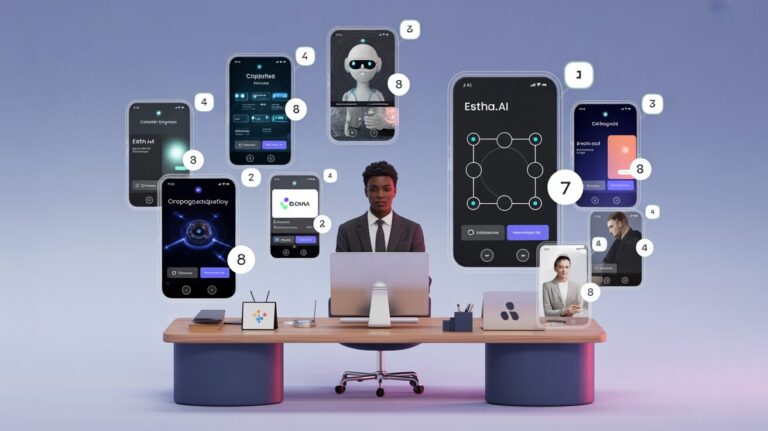Table Of Contents
- Understanding AI Personal Assistant Builders
- How AI Personal Assistant Builders Work
- Key Features to Look for in AI Personal Assistant Builders
- Use Cases and Applications Across Industries
- Benefits of No-Code AI Assistants for Businesses and Professionals
- Getting Started: Building Your First AI Personal Assistant
- The Future of AI Personal Assistants
- Conclusion: Embracing the AI Revolution
The world of artificial intelligence has undergone a remarkable transformation in recent years. What was once the exclusive domain of data scientists and developers is now becoming accessible to everyone—regardless of their technical background. At the forefront of this democratization of AI technology are AI Personal Assistant Builders: platforms that empower ordinary people to create sophisticated AI applications without writing a single line of code.
If you’ve ever wished you could build a custom AI assistant that understands your business, speaks in your brand voice, and helps you automate tasks or engage with customers, you’re in the right place. This comprehensive guide will walk you through everything you need to know about AI Personal Assistant Builders, from understanding what they are to creating your very first AI application in minutes.
Whether you’re a small business owner looking to enhance customer support, a content creator seeking to engage with your audience in new ways, or simply curious about how AI can be harnessed without technical expertise, this article will demystify AI assistant builders and show you how platforms like Estha are making advanced AI accessible to everyone.
AI Personal Assistant Builders
Transforming how businesses create custom AI applications
What Are AI Personal Assistant Builders?
Platforms that allow anyone to create customized AI applications without programming skills or technical knowledge, using intuitive interfaces with pre-built components.
No-Code Platform
Create AI applications without writing a single line of code
Domain-Specific
Train on your knowledge to create specialized AI assistants
Key Benefits
Time-Saving
Build in minutes, not months
Accessible
No technical skills required
Cost-Effective
10-100x cheaper than custom development
Popular Use Cases
Customer Service Bots
24/7 support for common questions
Educational Platforms
Interactive learning experiences
Product Advisors
Personalized recommendations
Professional Services
Preliminary guidance & screening
How to Build Your Own AI Assistant
Define Your Assistant’s Purpose
Identify the specific problem your AI will solve and who will use it.
Choose a No-Code Platform
Select a platform like Estha that matches your needs and skill level.
Upload Your Knowledge
Provide documents, FAQs, or information relevant to your domain.
Configure, Test & Launch
Design conversation flows, customize personality, test thoroughly, and deploy.
Ready to Create Your Own AI Assistant?
Build a custom AI application in minutes—no coding required.
Understanding AI Personal Assistant Builders
AI Personal Assistant Builders are platforms that allow users to create customized AI applications without requiring programming skills or deep technical knowledge. These tools have emerged in response to a growing demand for personalized AI solutions across various industries and use cases.
At their core, AI Personal Assistant Builders are no-code platforms that simplify the process of creating AI-powered applications by providing intuitive user interfaces, pre-built components, and guided workflows. They abstract away the complexities of AI models, natural language processing, and machine learning algorithms, making these powerful technologies accessible to non-technical users.
Unlike general-purpose AI assistants such as Siri or Alexa, custom AI assistants created through these platforms can be tailored to specific domains, knowledge bases, and brand voices. This customization makes them particularly valuable for businesses and professionals who need AI solutions that reflect their unique expertise and meet specific requirements.
The Evolution of AI Assistants
The journey to today’s accessible AI tools has been remarkable. Early AI systems required teams of engineers and data scientists to build and maintain. These systems were expensive, time-consuming to develop, and typically only available to large corporations with substantial resources.
As AI technology matured, we began seeing the emergence of developer platforms that simplified AI implementation, but these still required coding proficiency and technical understanding. The true breakthrough came with the introduction of no-code AI assistant builders, democratizing access to AI technology and empowering anyone to harness its capabilities.
Modern AI Personal Assistant Builders like Estha represent the culmination of this evolution—platforms designed specifically to eliminate technical barriers and make AI creation accessible to everyone from entrepreneurs and educators to healthcare professionals and content creators.
How AI Personal Assistant Builders Work
Understanding how AI Personal Assistant Builders function helps demystify what might otherwise seem like complex technology. These platforms operate on several key principles that make AI development accessible to non-technical users.
Visual Interface and Component-Based Design
AI Personal Assistant Builders typically feature intuitive, visual interfaces that replace coding with simple actions like dragging, dropping, and connecting elements. This component-based approach allows users to assemble sophisticated AI applications by combining pre-built modules, much like building with Lego blocks.
For example, Estha’s drag-drop-link interface lets users select AI capabilities (like conversation, knowledge processing, or decision-making), arrange them in a logical flow, and connect them to create functional applications—all without writing a single line of code.
The Technology Under the Hood
Behind the user-friendly interface, AI Personal Assistant Builders leverage several advanced technologies:
- Large Language Models (LLMs): These advanced AI systems understand and generate human-like text, forming the foundation for natural conversations.
- Natural Language Processing (NLP): This technology helps AI assistants understand user inputs, interpret questions, and provide relevant responses.
- Knowledge Bases: These structured repositories of information allow AI assistants to access and reference specific data when responding to queries.
- Workflow Automation: Built-in tools help connect various functions together to create logical flows of information and actions.
The magic of AI Personal Assistant Builders is that they abstract away this complexity, allowing users to focus on what they want their AI assistant to do rather than how the underlying technology works.
Customization Capabilities
What truly sets these platforms apart is their customization potential. Users can tailor their AI assistants by:
Training on specific knowledge: Upload documents, website content, or product information to create an AI that’s an expert in your specific domain.
Defining brand voice: Adjust the tone, style, and personality of responses to match your brand identity.
Creating custom workflows: Design specific interaction patterns and decision trees that guide users through processes unique to your business.
Integrating with existing systems: Connect AI assistants with your current tools and platforms for seamless operation.
Key Features to Look for in AI Personal Assistant Builders
Not all AI Personal Assistant Builders offer the same capabilities. When evaluating platforms, consider these essential features that differentiate basic tools from truly powerful solutions:
Ease of Use and Accessibility
The primary purpose of these platforms is to make AI creation accessible to non-technical users. Look for intuitive interfaces with visual builders that require no coding or prompting knowledge. The best platforms allow users to create functional AI applications in minutes rather than days or weeks.
Estha, for instance, is designed specifically for users without technical backgrounds, enabling anyone to build AI applications in just 5-10 minutes through a simple visual interface.
Customization Depth
The ability to deeply customize your AI assistant is crucial for creating applications that truly represent your brand and expertise. Top-tier platforms should allow you to:
- Train your AI on your specific knowledge domain
- Customize interaction flows and conversation patterns
- Adjust AI behavior and personality to match your brand voice
- Create different types of AI applications (chatbots, advisors, quizzes, etc.)
Integration Capabilities
For AI assistants to deliver maximum value, they need to work seamlessly with your existing digital ecosystem. Look for platforms that offer:
Website embedding options: The ability to integrate your AI assistant directly into your website with minimal technical effort.
API access: For more advanced users, API connections allow integration with various applications and services.
Mobile compatibility: Ensure your AI assistant works well on mobile devices, where many user interactions occur.
Export and sharing options: The ability to share your AI creation with team members or the public.
Scalability and Growth Support
As your needs evolve, your AI assistant builder should grow with you. Superior platforms offer:
Performance scaling: The ability to handle increased user loads as your audience grows.
Monetization options: Features that allow you to generate revenue from your AI creations, such as Estha’s EsthaSHARE marketplace.
Analytics and insights: Tools to understand how users are interacting with your AI assistant and where improvements can be made.
Ongoing education: Resources like Estha’s EsthaLEARN that help you continually improve your AI applications.
Use Cases and Applications Across Industries
AI Personal Assistant Builders are transforming how professionals across diverse industries work. These versatile platforms enable the creation of specialized AI solutions for numerous applications:
Small Business Applications
Customer service chatbots: Creating 24/7 support agents that answer common questions, troubleshoot issues, and guide customers through processes.
Product advisors: Developing AI assistants that help customers find the right products based on their needs and preferences.
Appointment scheduling: Building interactive assistants that handle booking, rescheduling, and reminders without human intervention.
Content Creation and Education
Interactive learning modules: Creating engaging educational experiences that adapt to student needs and provide personalized guidance.
Content companion: Developing assistants that help content creators brainstorm ideas, overcome writer’s block, or check facts.
Interactive quizzes and assessments: Building AI-powered evaluations that provide instant feedback and personalized recommendations.
Professional Services
Legal and financial advisors: Creating AI assistants that provide preliminary guidance on common questions while clarifying when human expertise is needed.
Healthcare information assistants: Developing tools that help patients understand health information or navigate healthcare systems.
Coaching and mentoring: Building AI companions that provide ongoing support and accountability for personal or professional development.
Real-World Success Stories
Across these industries, professionals are seeing tangible benefits from custom AI assistants:
A small e-commerce business might use an AI product advisor to increase conversion rates by 35% while reducing return rates by helping customers find the right products the first time.
An educational content creator could deploy an interactive AI tutor that engages students for twice as long as traditional content, resulting in better learning outcomes and higher satisfaction.
A solo consultant might leverage an AI pre-screening assistant to qualify leads and gather initial information, allowing them to focus their limited time on high-value client interactions.
Benefits of No-Code AI Assistants for Businesses and Professionals
The growing popularity of AI Personal Assistant Builders stems from the significant advantages they offer to businesses and professionals across all levels of technical expertise:
Democratization of AI Technology
The most revolutionary aspect of these platforms is how they make cutting-edge AI accessible to everyone. This democratization has several profound implications:
Leveling the playing field: Small businesses can now deploy AI capabilities that were previously only available to large enterprises with substantial development resources.
Empowering domain experts: Professionals with specialized knowledge can create AI tools that reflect their expertise without needing to collaborate with developers or learn programming.
Accelerating innovation: When more diverse voices can contribute to AI development, we see more creative and specialized applications emerge that address previously overlooked needs.
Efficiency and Productivity Gains
AI assistants deliver significant operational benefits:
24/7 availability: Unlike human staff, AI assistants can provide continuous service without breaks, ensuring inquiries are addressed at any time.
Handling routine inquiries: By automating responses to common questions, AI assistants free up human time for more complex tasks that require creativity, empathy, or specialized reasoning.
Scaling operations: AI assistants can handle virtually unlimited simultaneous conversations, allowing businesses to grow without proportionally increasing support staff.
Cost-Effectiveness and ROI
The economic advantages of no-code AI assistants are compelling:
Reduced development costs: Building AI applications through no-code platforms can be 10-100x less expensive than custom development.
Lower maintenance requirements: Updates and improvements to AI assistants can be implemented quickly without specialized technical support.
Rapid implementation: The time-to-value is dramatically shortened, with functional AI assistants deployable in days or even hours rather than months.
Enhanced Customer Experience
Well-designed AI assistants elevate the customer journey:
Immediate responses: Customers receive instant answers rather than waiting for human availability.
Consistency: AI assistants deliver reliable, accurate information without the variability that can occur with human representatives.
Personalization at scale: By remembering past interactions and preferences, AI assistants can provide personalized service to every customer simultaneously.
Getting Started: Building Your First AI Personal Assistant
Ready to create your own AI assistant? This step-by-step guide will help you navigate the process from concept to deployment:
Defining Your AI Assistant’s Purpose
Before diving into building, clarify what you want your AI assistant to accomplish:
Identify the primary goal: What specific problem will your AI assistant solve? Is it answering product questions, providing guidance in a particular field, or facilitating a process?
Define the scope: What should your assistant be able to help with, and what falls outside its capabilities? Clear boundaries help create a more effective tool.
Consider your audience: Who will be interacting with your AI assistant? Understanding their needs, technical comfort level, and common questions will shape your design decisions.
Choosing the Right Platform
Selecting a platform like Estha that aligns with your needs is crucial:
Evaluate ease of use: If you have no technical background, prioritize platforms with intuitive visual builders.
Consider customization needs: Ensure the platform allows you to tailor the AI assistant to your specific knowledge domain and brand voice.
Check integration options: Verify that the platform can integrate with your existing website, tools, or systems.
Review pricing and scalability: Choose a platform that fits your current budget but can grow with you as your needs evolve.
The Building Process
With a platform selected, follow these steps to create your AI assistant:
- Set up your knowledge base: Upload relevant documents, FAQs, product information, or expertise that will inform your AI assistant’s responses.
- Design the conversation flow: Map out how interactions will progress, including greetings, question handling, and follow-up processes.
- Customize the personality: Define the tone, style, and character of your AI assistant to align with your brand voice.
- Test thoroughly: Before deployment, extensively test your AI assistant with diverse questions and scenarios to ensure it responds appropriately.
- Deploy and integrate: Once satisfied, integrate your AI assistant into your website, share it with your audience, or embed it in your relevant digital channels.
Continuous Improvement
Building your AI assistant isn’t a one-time project but an ongoing process:
Monitor performance: Review analytics to understand how users are interacting with your assistant and identify common questions or pain points.
Gather feedback: Actively solicit input from users about their experience and what could be improved.
Update regularly: Refine your AI assistant’s knowledge, responses, and capabilities based on performance data and user feedback.
With platforms like Estha, this continuous improvement process is streamlined through intuitive interfaces that make updates and refinements quick and straightforward.
The Future of AI Personal Assistants
As we look ahead, several exciting trends are shaping the evolution of AI Personal Assistant Builders and their applications:
Emerging Trends and Technologies
Multimodal AI capabilities: Future AI assistants will increasingly work with multiple types of data—text, images, audio, and video—enabling richer interactions and capabilities.
Enhanced personalization: As AI models improve, assistants will deliver increasingly customized experiences based on individual user preferences, history, and context.
Greater autonomy: AI assistants will become more capable of handling complex tasks and making decisions within defined parameters, further reducing the need for human intervention.
Seamless cross-platform experiences: AI assistants will provide consistent interactions across websites, mobile apps, voice devices, and messaging platforms.
How AI Assistants Will Transform Industries
The widespread adoption of customizable AI assistants will reshape how businesses operate:
Hybrid customer service models: Organizations will deploy AI assistants for routine interactions while human agents focus on complex issues and relationship building, creating more efficient and satisfying customer experiences.
Personalized education: AI tutors will adapt to individual learning styles and pace, providing customized educational experiences at scale.
Proactive health management: Healthcare AI assistants will help monitor conditions, provide medication reminders, and offer guidance between professional appointments.
Creative collaboration: Content creators and artists will increasingly collaborate with AI assistants that can generate ideas, provide feedback, and handle routine aspects of creative work.
Preparing for an AI-Enhanced Future
To make the most of these advancements, professionals and businesses should:
Develop AI literacy: While coding knowledge remains unnecessary, understanding AI capabilities, limitations, and best practices will be increasingly valuable.
Focus on uniquely human skills: As AI handles more routine tasks, human creativity, emotional intelligence, ethical judgment, and complex problem-solving become more important.
Experiment early: Organizations that gain experience with AI assistants now will develop valuable insights and competitive advantages as the technology evolves.
Address ethical considerations: Thoughtfully implement AI with attention to transparency, privacy, and responsible use to build user trust.
Conclusion: Embracing the AI Revolution
AI Personal Assistant Builders represent one of the most significant democratizing forces in technology today. By removing technical barriers and making sophisticated AI capabilities accessible to everyone, these platforms are revolutionizing how individuals and businesses leverage artificial intelligence.
No longer restricted to corporations with large development teams, the power of custom AI is now available to entrepreneurs, educators, content creators, healthcare professionals, and individuals from all walks of life. This accessibility is driving innovation as diverse perspectives and domain expertise shape new AI applications that address previously unmet needs.
As we’ve explored throughout this guide, creating your own AI personal assistant no longer requires coding skills, technical knowledge, or significant financial investment. With intuitive platforms like Estha, anyone can transform their expertise into interactive, intelligent applications in minutes rather than months.
Whether you’re looking to enhance customer service, create interactive educational experiences, streamline operations, or explore new ways to share your knowledge, AI Personal Assistant Builders provide the tools you need to bring your vision to life. The future of AI is not just about what technology can do—it’s about who can use it. And increasingly, that answer is everyone.
Ready to Build Your Own AI Personal Assistant?
Get started today and create your custom AI application in minutes—no coding required.



